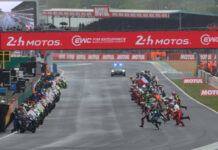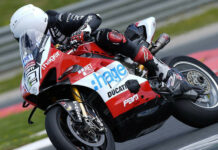Copyright 2002, Roadracing World Publishing, Inc.
By David Swarts
Honda’s all-new CBR600RR and Kawasaki’s hard-edged ZX-6RR have raised the level of competition forthe 2003 AMA Supersport series, but Yamaha’s YZF-R6–which doesn’t look all-new–will be a contender.
At least that’s what Yamaha factory road race mechanic Jeff Myers says.
“I would have to say one of the most obvious things is the chassis itself,” said Myers. “The technology they’re using there, it’s basically a cast chassis rather than stamped pieces welded together. So the accuracy and rigidity of the chassis has been much improved over past models. They’re claiming the same kind of rigidity as the R7, as far as torsional rigidity. I think that’s going to be a big improvement.
“Obviously, the fuel injection is going to help keep a flatter fuel curve. We’re not going to have the rich/lean area you have with carburetion. It’s pretty hard to get a flat fuel curve with carburetors. So the fuel injection is going to help us there.
“They changed the way the axle clamps on the forks, and things like that that should again improve on the rigidity of the whole package.
“They changed the geometry. They took a little bit of offset out of it, which gave a us a little more trail which will help us on the track, too.
“The new air intake system doesn’t look a whole lot different from our old system as far as volume and stuff like that. I think the airbox might have a little more volume than the past one, but it’s minimal.
“The engine has been changed. I’d say 80 percent of the parts in the engine are new. There’s only a 15-20 percent of carryover parts from the previous R6. Some of the issues that they’ve addressed there that should help out is they got rid of the liners in the cylinder. Now it’s direct plating on the cylinder bores, so bore accuracy, I think, is going to be improved. The cooling of the engine with no liner, heat transfer, should be better. They changed the radiator on it. We have a larger curved radiator now, so the bike should be running a little cooler than they have in the past. That’s always ran a little hot for us, for our liking. That’s going to help there, too. Changes to the transmission. The ratios are essentially the same, but the dogs and the tooth faces have been changed.
“Little things like that are small improvements that add up. If you start looking at, like the Kawasaki, having an RR model and the obvious things they’re touting, adjustable (swingarm) pivot, comes with slotted cam sprockets, well that’s kind of a moot point. The adjustable pivot’s a nice feature, but some of the other things they beat their chest about on that bike, we can do that to ours. So it’s not really an issue.
“The Honda, they’re claiming a lot of parallels with their GP bike, as far as suspension. It’s still got to be damped and all that.
“I think our bike isn’t extremely different. I think the development process, what we’ve learned with the older bike, should cross over into this bike a little easier than like with the Honda. From like their F4i to their new one, they’re talking about a whole different package, learning that. There’ll be a bit of a learning curve for them that we probably aren’t going to be faced with. We’ll see what happens.”
Myers said Yamaha plans to shake down the new 600s during an upcoming test before heading to Daytona for the annual Dunlop tire test in early December.
In 2002, Myers led the three-rider factory Yamaha Supersport racing effort, but in 2003, Myers will share those duties with Tony Romo.
“They re-structured the team a little bit,” said Myers. “Basically, the factory effort is 600-only for Yamaha next year. The people who were involved in Superbike are obviously moved into a 600 capacity this year. So we have Tony (Romo) directing one side of the 600 team, two mechanics and two riders; and I’ll be directing the other side of the 600 team, two mechanics and two riders. Engine building duties and all that kind of stuff get split up between Tony and me.
“I think last year we learned kind of a lesson. One guy overseeing three guys is a little much. It’s not really fair to the riders. Of course with our team, we had a lot of injuries last year. I think it wasn’t until Laguna Seca, because we had all three guys healthy at the track for the first time. We went, ‘Whoa! This isn’t really working.’ Daytona was the first race we had to deal with that format, and then we didn’t have to deal with it again until Laguna Seca and the races following. We learned then that it wasn’t the best system. We worked on that this year with the team structure.
“I’m not really sold,” said Myers when asked about the rule proposal to allow electric shifters in AMA Supersport racing in 2003. “Obviously there were teams running shift kills last year and actually the year before. Honda, Suzuki, Kawi; all of them pretty much were running it last year. I can tell you we weren’t, and we were right in there at several races. Granted, we really didn’t get to the top of the box last year in 600, but we got a few second-place finishes and we’re not running it. If you look at qualifying times and lap times, we did have some pole positions.
“So is there a whole lot of advantage to having a shift kill? How much time is really saved having it versus not having it? I think it’s kind of nice having it because psychologically riders like having it. So I think it’s a benefit from that point. How that parlays into seconds off a lap time, who knows? I can’t really say from my first-hand experience that it’s going to make a difference, but it’s kind of nice having the ability to play with that. Some of the other rule changes they pushed through I questioned.”
Yamaha: YZF-R6 Has Been Improved Enough To Be A Contender
Yamaha: YZF-R6 Has Been Improved Enough To Be A Contender
© 2002, Roadracing World Publishing, Inc.






